


Experiments with magnets and conductors
Magnetic Plumb
Description:
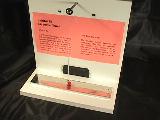
This is another demonstration of Lenz's
law and Eddy currents, similar to the Pendulum and Aluminum Disk, but this time, the magnet moves with respect to the
conductor. Here, a magnet hangs suspended by a string above a thick copper
bar. Moving the magnet around by hand allows you to feel the strength of the induced
magnetic fields. When the magnet isn't moving, there is no induced field.
Construction: ![]()

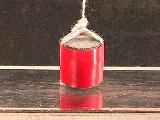
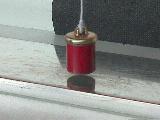
Three NIB magnets, each measuring about 1/2" diameter and 1/8"
thick, are put together. A string is wound around them several times and taped,
providing a way to hang the magnets from a string. (The photo on the right is an
improvement I recently made to this. I attached the string to a steel button with a
flat face. The magnets attach to the face of the button. This is much cleaner
and neater than using several windings of string and tape. The magnets now hang
straighter. I left the tape on there to keep the magnets in line.)
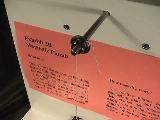
The magnets on a string are hung from a 4" 1/4x20 bolt attached to
the back of the exhibit. At the end of the bolt is a tee-nut, flat washer and hex
nut. The string goes through one of the small holes in the tee-nut and is wrapped
once around the bolt. The washer and hex nut then hold the string in place.
The stand is made of 3/4" pressboard shelving covered with white melamine. This
makes a nice, clean exhibit.
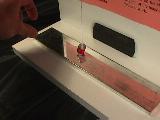
On the bottom of the exhibit is fastened a 1/4" thick bar of copper,
about 3" wide and 9" long. The length of the string should be adjusted so
that the bottom of the magnets is only 1/16" to 1/8" from the surface of the
copper bar. The copper bar shown in the photo is tin plated so it would not tarnish,
however the tarnish does not affect the way the magnet behaves. There is a foam pad
on the back board so the magnet won't whack against the board and chip itself or the
board's surface.
Demonstration:
Gently move the magnet on the string back and forth about 1" or
2". Can you feel the drag created when the magnet is moving? Let it swing
about 1" from vertical. Now let it swing about 4" from vertical. How
does it behave when it gets closer to the bar of copper?
Conclusions:
The relative motion between the conducting plate and the magnetic field induces currents in the copper plate which create magnetic fields. The orientation of the created magnetic fields is such that it opposes the motion of the swinging magnet, causing it to stop.
This would also work well with a thick piece of aluminum, perhaps 1/2" thick or more.
This is a simplified diagram showing the areas of attraction and repulsion in this experiment.
